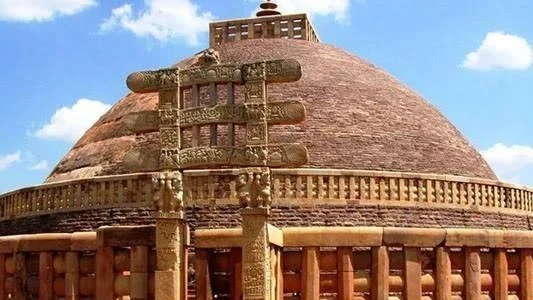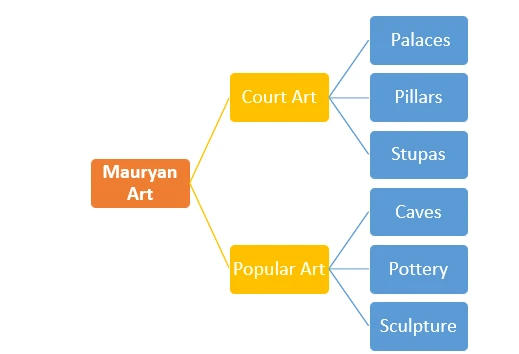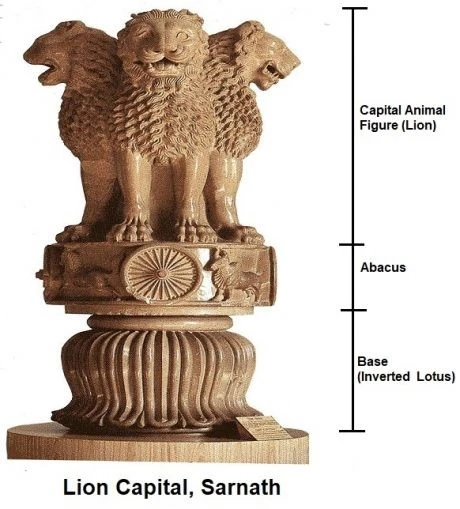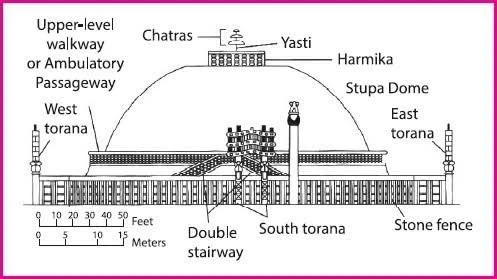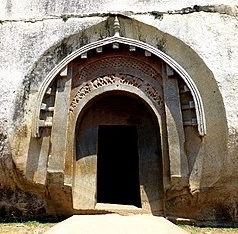Mauryan Art and Architecture, consisting of court and popular art, experienced an epoch of significant growth, showcasing grand palaces, intricate inscriptions on pillars, and remarkable stupas. Artistic expressions were deeply influenced by Buddhism and Jainism, resulting in a blend of spiritual aesthetics and timeless appeal. In this article, you will learn about Mauryan Art and Architecture including Court Art and Popular Art, which is an import topic for Art & Culture subject of GS Paper-1 Ancient India of UPSC CSE Exam. To explore more interesting concepts similar to Basic Feature of Hindu Temple, check out other IAS Notes and articles of IASToppers.
Table of Content
- Background of Mauryan Art and Architecture
- Court Art of Mauryan Art and Architecture
- Palaces
- Pillars
- Stupa
- Popular Art of Mauryan Art and Architecture
- Cave Architecture
- Sculptures
- Pottery
- Conclusion
Background of Mauryan Art and Architecture
- The onset of the 6th century BCE signified a transformative period in the Gangetic valley with the emergence of Jainism and Buddhism, both integral components of the shraman tradition.
- These religions rose to prominence as they rejected the Hindu caste and sub-caste systems. They challenged the Vedic age’s ‘varna’ and ‘jati’ systems.
- By the fourth century BCE, the Mauryas had established their rule, and by the third century BCE, they held sway over a vast portion of India.
- Ashoka, the most influential ruler of the Mauryan dynasty, supported the Buddhist shraman tradition in the third century BCE.
- With the rise to power of the Mauryas, a distinction emerged between architectural and sculptural works supported by the State and those fostered by individual efforts.
Based on this, art and architecture of Mauryan empire can be categorized in below manner:
Features of Mauryan art and architecture
Court Art of Mauryan Art and Architecture
The Mauryan reign was marked by a flurry of construction activities, driven by both political and spiritual motivations. These architectural marvels, known as Court Art, hold a significant place in history.
Palaces
- The rise of the Mauryan Empire marked the beginning of a strong and influential reign in India.
- They built the city of Pataliputra and the royal palace at Kumrahar to showcase the grandeur of their rule.
- The palace of Chandragupta Maurya was modelled after the Achaemenid palaces of Persepolis in Iran.
- The primary construction material was timber.
- Megasthenes, the historian, praised the palace as one of the most impressive human constructs. Chinese traveller Fa Hien called these palaces as God gifted monuments.
- Ashoka’s grand palace at Kumrahar was another splendid structure, having a tall central pillar and three floors, all constructed of wood.
- The walls of the palace were adorned with intricate carvings and sculptures.
Pillars
- During Ashoka’s rule, the tradition of inscription on pillars became prominent.
- These inscriptions served dual purposes – to symbolize the state and celebrate military triumphs. They were also used by Ashoka to disseminate his imperial sermons.
- The majority of Ashoka’s pillar edicts were inscribed in Pali and Prakrit, but some were also etched in Greek or Aramaic.
- The pillars, about 40 feet in height, were typically carved from chunar sandstone and composed of a Shaft and a Capital.
- A lengthy Shaft, carved from a single stone block or monolith, formed the foundation. Atop this stood the Capital, which was either designed to resemble a lotus or a bell.
- The bell-shaped capitals bore a resemblance to Iranian pillars. A distinctive feature of these pillars was their polished and shiny surface.
- Resting above the capital was the abacus, a circular or rectangular platform where an animal figure was usually installed.
- The Lauria Nandangarh Pillar in Champaran and the Sarnath Pillar near Varanasi are classic examples of such structures.
Common elements between Achaemenian Pillars and Ashokan Pillars
- They were both crafted from polished stone and displayed common design elements like the lotus.
- The concept of engraving proclamations (typically related to Buddhist teachings and royal edicts) on pillars, as seen in Maurya’s pillars, has roots in the tradition of Persian pillars.
- The inscriptions on pillars from both these empires typically start in the third person and transition to the first person.
Difference between Achaemenian Pillars and Ashokan Pillars
| Feature | Mauryan Pillars | Achaemenid Pillars |
| Capital figure | No | Yes |
| Lotus shape and ornamentation | Different than Achaemenid | Different than Mauryan |
| Pillar surface | Smooth | Fluted or ridged |
| Architectural scheme | Simple and independent freestanding monuments | Part of a larger architectural scheme |
| Shaft | Made of a single piece of stone (monolith) | Made of separate segments of stone |
Ashoka’s Pillar Edicts
The Major Pillar Edicts of Ashoka were inscribed on the Pillars of Ashoka at Kausambi (now Allahabad pillar), Topra Kalan, Meerut, Lauriya-Araraj, Lauria Nandangarh, Rampurva (Champaran), Kandahar (fragment) and Pul-i-Darunteh (fragment)
- Pillar Edict I: Ashoka’s commitment to safeguarding his people.
- Pillar Edict II: Elaborates on the concept of Dhamma, defining it as a lifestyle with minimal sin and abundant virtues, compassion, generosity, honesty, and purity.
- Pillar Edict III: Preach to refrain from negative behaviors such as cruelty, anger, arrogance, and other sinful acts.
- Pillar Edict IV: Outlines the roles and responsibilities of Rajukas, who were to travel to various parts of the empire every five years to promote the principles of Dhamma.
- Pillar Edict V: Includes a compilation of animals and birds that were not to be harmed on specific days, as well as another list of animals that were always to be protected. It also mentions Ashoka’s act of liberating 25 prisoners.
- Pillar Edict VI: Dhamma policy
- Pillar Edict VII: Describes the actions undertaken by Ashoka to implement the policy of Dhamma. It states that all religious groups aspire towards self-discipline and mental purity.
Minor Edicts
Asoka’s Minor Pillar Edicts are inscribed on several of the Pillars of Ashoka, at Sarnath, Sanchi, Allahabad (a pillar initially located in Kosambi), Rummindei and Nigali Sagar.
- Lumbini (or Rummindei) Pillar Edicts: Written in Brahmi script, they contain details of their establishment. These edict recount Emperor Ashoka’s journey to Lumbini, in the Rupandehi district of Nepal, recognized as the birthplace of Buddha. Ashoka granted Lumbini a tax-free status and decreed that its grain offering would amount to only an eighth of the usual requirement.
- Nigalisagar Pillar Inscription, Nepal: It mentions Ashoka’s dedication for the enlargement of the Stupa dedicated to the Kanakamuni Buddha.
Stupa
- The stupa is a significant historical monument, originating from India during the Vedic era.
- Its design is similar to a burial mound where the remains and relics of the deceased were preserved.
- It was during Emperor Ashoka’s reign that the construction of stupas reached its peak, with 84,000 structures built during his time.
- Though rooted in Vedic traditions, stupas gained prominence through Buddhist practices.
- Following Buddha’s demise, nine such structures were erected.
- These 9 stupas were built at Rajagriha, Vaishali, Kapilavastu, Allakappa, Ramagrama, Vethapida, Pava, Kushinagar and Pippalivana.
- Among these, eight housed Buddha’s relics within their circular terrace (medhi), while the ninth contained a pot that originally held the relics.
- The heart of the stupa was constructed with raw bricks, and its exterior was made using fired bricks. This was then covered with plaster.
- The medhi and the toran (ceremonial gateways) were adorned with intricate wooden carvings.
- The design of a Stupa incorporates a cylindrical body with a round “anda” on top, which is then capped by a “harmika” and a “chhatra“.
- The anda, a semi-spherical mound, symbolizes the heap of earth used to conceal Buddha’s remains.
- Harmika is a square enclosure that sits atop the mound.
- Chhatra is a key pillar that holds up a structure resembling a triple-tiered umbrella.
- As a sign of reverence, followers would circumnavigate the open walkway known as the ‘pradakshina patha’ surrounding the stupa.
- Examples: Sanchi Stupa (Madhya Pradesh), Piprahwa stupa (oldest stuapa), Uttar Pradesh.
Popular Art of Mauryan Art and Architecture
- The rise of art and architecture in the form of cave-carvings, sculptures, and ceramics wasn’t solely due to royal patronage but was also the result of individual creativity.
Cave Architecture
- Rock-cut cave were used as viharas, meaning living spaces, for Jain and Buddhist monks during the Mauryan era.
- Initially, the Ajivika sect utilized these caves, but over time, they gained popularity as Buddhist monasteries.
- These Mauryan-era caves had glossy smoothness of their interior surfaces and had decorative gateways.
Example of Cave Architecture
- Barabar and Nagarjuni caves in Bihar, created during the reign of Ashoka and his grandson Dasharatha (in 3rd century BC.) are rock-cut caves.
- In the district of Jehanabad, Bihar, there exist seven caves, referred to as Satgarva. These caves were carved out by Emperor Ashoka, with the purpose of serving the Ajivika Sect.
- First four caves are collectively known as the Barabar Caves: Karna Chaupar Cave, the Sudama Cave, the Lamarshi Cave (Lomas Rishi Cave), and the Vishwamitra Cave (Vishva Zopri Cave).
- Other three caves, known as the Nagaragunja Caves, came into existence during the rule of Dasharath, Ashoka’s grandson. These caves are named the Gopi Cave, the Bahayak Cave, and the Vedantika Cave.
Nasik Caves
- These are a collection of 24 Buddhist caves, also referred to as “Pandav Leni“, carved between the 1st century BC and the 3rd century AD, and belong the Hinayana era.
- Over time, the impact of the Mahayana sect also became visible within these caves.
- In the context of Hinayana Buddhism, motifs and symbols like thrones and footprints were used to signify the presence of Buddha.
- Subsequently, statues of Buddha were sculpted within these caves, reflecting the influence of Mahayana Buddhism.
- The site also showcases an impressive water management system, as evidenced by the water tanks carved out from solid rocks.
Sculptures
- During Mauryan Empire, sculptures held significant importance as they served as adornments for stupas in the torana and medhi and were a medium of religious expression.
- Noteworthy among these sculptures are the depictions of Yaksha and Yakshi, which are objects of worship in the three major religions of Jainism, Buddhism, and Hinduism.
- The earliest reference to Yakshi is present in a Tamil literature piece, the Silappadikaram.
- Moreover, each Jain Tirthankar was traditionally linked to a Yakshi.
Pottery
- The Mauryan period saw the emergence of a unique pottery style known as Northern Black Polished Ware (NBPW).
- These artifacts stood out due to their black coloring and shiny finish, making them luxury goods.
- The craftsmanship of these pottery pieces is often held in high regard.
Conclusion
Development of art and architecture during Mauryan period marked an epoch of remarkable growth, reflected in the grand palaces, intricately inscribed pillars, and stupas that are still revered today. The influence of Buddhism and Jainism during this time shaped the aesthetics and spiritual motifs of art and architecture of mauryan dynasty, contributing to the timeless appeal of art and architecture during the Mauryan period.
Ref:
FAQs(Frequently Asked Questions)
What are the key features of Mauryan art and architecture?
Key features of Mauryan art and architecture include grand palaces symbolizing royal grandeur, intricate inscriptions on pillars representing both political and spiritual edicts, stupas commemorating Buddhist practices, and popular art including cave-carvings, sculptures, and ceramics inspired by Buddhism and Jainism.
What distinguishes Court Art in Mauryan Art and Architecture?
Court Art in Mauryan era is characterized by grand constructions like palaces and intricately inscribed pillars, showcasing the empire’s political and spiritual ideologies, reflecting a strong Persian influence in the architectural designs.
What role did Buddhism play in shaping Mauryan Art and Architecture?
Buddhism significantly influenced Mauryan Art and Architecture, fostering the creation of stupas, inscriptions on pillars reflecting Buddhist teachings, and cave architecture serving as Buddhist monasteries. These influences brought a spiritual depth and distinct aesthetic to the art and architecture of the Mauryan period.



